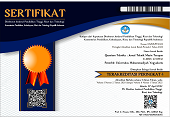Analisis Pengujian Tarik dan Sebaran unsur pada Pengelasan Aluminium – Mild Steel menggunakan Metode Cold Metal
Abstract
Keywords
Full Text:
PDFReferences
Jácome, L. A., Weber, S., Leitner, A., Arenholz, E., Bruckner, J., Hackl, H., & Pyzalla, A. R. 2009. Influence of filler composition on the microstructure and mechanical properties of steel-Aluminum joints produced by metal arc joining. Advanced Engineering Materials, 11(5), 350-358.
Kang, M., & Kim, C. 2015. Joining Al 5052 alloy to aluminized steel sheet using cold metal transfer process. Materials & Design, 81, 95-103.
Milani, A. M., Paidar, M., Khodabandeh, A., & Nategh, S. 2016. Influence of filler wire and wire feed speed on metallurgical and mechanical properties of MIG welding–brazing of automotive galvanized steel/5754 aluminum alloy in a lap joint configuration. The International Journal of Advanced Manufacturing Technology, 82(9), 1495-1506.
Qiu, R., Shi, H., Zhang, K., Tu, Y., Iwamoto, C., & Satonaka, S. 2010. Interfacial characterization of joint between mild steel and aluminum alloy welded by resistance spot welding. Materials Characterization, 61(7), 684-688.
Singh, J., Arora, K. S., & Shukla, D. K. 2019. Dissimilar MIG-CMT weld-brazing of aluminium to steel: A review. Journal of Alloys and Compounds, 783, 753-764.
Srinivasan, D., Sevvel, P., Solomon, I. J., & Tanushkumaar, P. 2022. A review on Cold Metal Transfer (CMT) technology of welding. Materials Today: Proceedings.
DOI: https://doi.org/10.18196/jqt.v4i1.16092
Refbacks
- There are currently no refbacks.
Copyright (c) 2022 Quantum Teknika : Jurnal Teknik Mesin Terapan

This work is licensed under a Creative Commons Attribution-NonCommercial 4.0 International License.
Quantum Teknika : Jurnal Teknik Mesin Terapan is indexed by :
Office:
Editorial of Quantum Teknika, Building D, Jl. Brawijaya, Tamantirto, Kasihan, Bantul, Yogyakarta.Telp: (0274) 387656
Fax: (0274) 387646
WA: +62896-7470-8638 (Mirza Yusuf)
Email: jqt@umy.ac.id

Quantum Teknika : Jurnal Teknik Mesin Terapan is licensed under a Creative Commons Attribution-NonCommercial 4.0 International License.















.png)